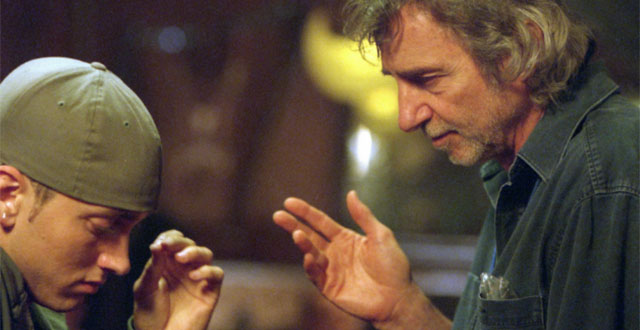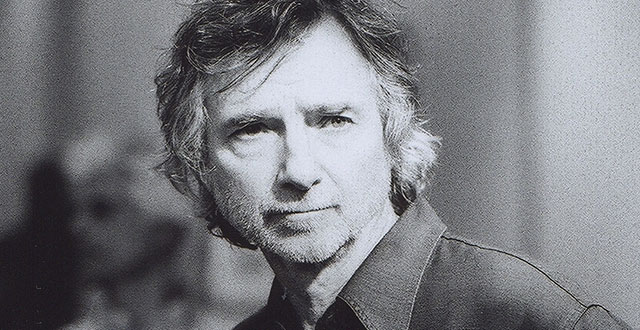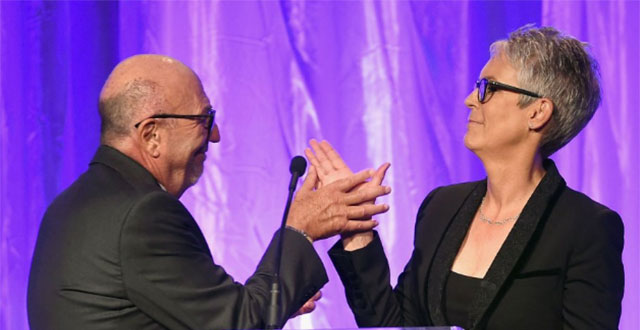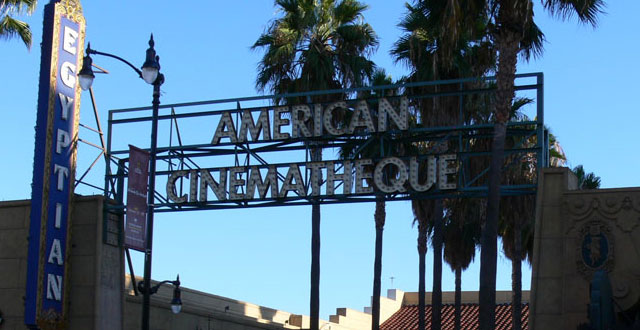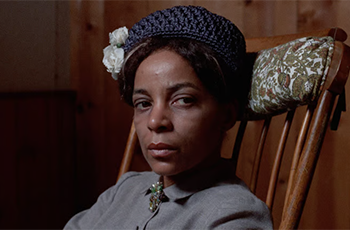News
Critic's Notebook: Curtis Hanson, a Late Bloomer Worth Waiting For
Stephen Dalton
Hitting his stride in the late '90s, 25 years into his career, the director of 'L.A. Confidential,' 'Wonder Boys' and '8 Mile' was an unpretentious all-rounder touched by occasional genius.
A late bloomer by fate, an all-rounder by necessity, Curtis Hanson (who died Tuesday at age 71) began his filmmaking career as a high-school dropout and Venice Beach surf bum. The future director of L.A. Confidential never went to film school, finding his way into Hollywood by a more scenic route that included decades of false starts and dead ends. But Hanson was persistent, and his dogged dedication finally paid him back. It makes a poetic kind of sense that he was drawn to stories about people "trying to find better versions of themselves," as he's been widely quoted as saying.
He first entered the outer fringes of the film industry by writing and editing his own movie magazine, Cinema. This brought him into personal contact with his directing heroes, single-minded American mavericks from an earlier age like John Ford, Howard Hawks and Don Siegel. "They had an independence about them," he once explained in an interview for The New York Times. "They weren't pretentious. They survived."
READ MORE: Curtis Hanson, Director and Oscar-Winning Writer on 'L.A. Confidential,' Dies at 71
Resilience was certainly key to Hanson's early career, which was hobbled by setbacks and scandals. Like so many of his generation, he started in movies by writing and directing pulpy quickies for Roger Corman's legendary low-budget outfit AIP. Greater opportunities seemed to knock when Roman Polanski, hot from his success with Chinatown, signed on to direct Hanson's adaptation of French novelist Romain Gary's anti-racist allegory White Dog. But the film fell apart when Polanski was charged with statutory rape and fled the country.
Paramount later revived White Dog as a collaboration between Hanson and his directing hero, the legendary Sam Fuller. However, the studio got cold feet again, suppressing the film's U.S. release in 1982 over fears it could be misinterpreted as racist. White Dog finished off Fuller's American career, though it later earned a cult following, and he remained on good terms with Hanson until his death in 1997.
Hanson's juvenile writing and directing efforts are mostly faceless genre exercises, but one early pointer to future greatness is his screenplay to Daryl Duke's The Silent Partner (1978), a Canadian heist thriller starring Elliott Gould, Christopher Plummer and Susannah York. Reviewers likened this taut crime caper to vintage Hitchcock and, indeed, Gould later screened it privately for the master of suspense himself. Hanson was aggrieved not to be invited, but placated when he heard that Hitch loved the movie.
Notable solely for launching Tom Cruise's career as a leading man, the lame sex comedy Losin' It (1982) was one of Hanson's handful of journeyman directing credits in the 1980s. But as before, he stoically persisted until his career-making break finally arrived with The Hand That Rocks the Cradle (1992), a roaring rampage of female revenge starring Rebecca DeMornay, Annabella Sciorra and Julianne Moore.
Further box-office success came with The River Wild (1994), a kinetic backwoods thriller starring Meryl Streep and Kevin Bacon. Grossing around $90 million each, these two films gave Hanson the financial leverage to move into more mainstream Hollywood fare, though both still stand on their own merits as superior and rare female-driven action vehicles.
The stars finally aligned for Hanson in his early fifties when he co-wrote, co-produced and directed his magisterial adaptation of James Ellroy's sprawling retro-noir novel L.A. Confidential (1997). Featuring an all-star ensemble cast, this sumptuous symphony of sleaze takes place in a meticulously recreated 1950s Los Angeles of treacherous fantasies and thwarted dreams.
Shooting in 45 locations, Hanson was obsessively keen to capture the precise texture of the post-war Los Angeles he remembered from childhood, a city of rapid urbanization and rampant corruption, where detectives were not Hollywood pretty boys but hard-drinking, chain-smoking, big-shouldered World War II veterans. He inspired his cast and crew by screening noir-era classics including Robert Aldrich's Kiss Me Deadly, Stanley Kubrick's The Killing, and Don Siegel'sThe Line-Up. He later called L.A. Confidential "my most personal movie."
A major critical and commercial success, L.A. Confidential won two Oscars, one for Hanson's joint screenplay with Brian Helgeland and another for Kim Basinger's indelible supporting role as the emotionally wounded femme fatale. The film also put Russell Crowe and Guy Pearce on the Hollywood map. Hanson brought these relative unknowns on board without informing producer Arnon Milchan that they were Australian.
Inundated with juicy offers after L.A. Confidential, Hanson's next project was Wonder Boys (2000), another all-star novel adaptation, this time Michael Chabon's bittersweet portrait of a washed-up English professor in a small New England college town. Michael Douglas gained weight and took a hefty pay cut to play the lead role alongside a stellar supporting cast including Frances McDormand, Robert Downey Jr., Katie Holmes and Tobey Maguire.
Wonder Boys performed poorly at the box office, but the reviews were almost universally positive, and Bob Dylan's theme song won an Oscar. It remains a classy piece of work, wise and compassionate, with the same exacting eye for character and location as L.A. Confidential. At the very least, it proved Hanson was no one-hit wonder boy himself.
In an incongruous career swerve, Hanson then tested his lucrative flexibility once more by helming 8 Mile (2002), a lightly dramatized Eminem biopic which scored both critical and commercial success. With Eminem at the peak of his infamy, directorial input was largely incidental to the film's box-office haul of over $240 million. Even so, Hanson elevates a rote rags-to-riches plot with high levels of artistry, capturing the urban fabric of Detroit in typically forensic detail. It is a rare kind of hip-hop movie, after all, that opens with a quote from John Updike.
Hanson's later films became steadily less sure-footed, effectively returning him to his roots as a versatile but faceless journeyman for hire. In Her Shoes (2005) is a formulaic but enjoyable dramedy starring Cameron Diaz and Toni Colette as squabbling siblings. But the strained Las Vegas gambling drama Lucky You (2007) was panned by critics and died at the box office.
Produced for HBO, Hanson's financial crisis drama Too Big to Fail (2011) is a solid and serious effort that picked up multiple Emmy and Golden Globe nominations. But his final directing credit, the teenage surfing drama Chasing Mavericks (2012), is an indifferent swan song that was overshadowed by bad luck and bad timing. The veteran British director Michael Apted was forced to finish the film when Hanson bowed out for health reasons.
A single-minded director for more than 40 years, Hanson's best work is full of heart, humanity and fine-grained Americana. He leaves us with at least one certified masterpiece, a few excellent dramas and a handful of superior experiments in genre. A late bloomer, yes, but when he finally bloomed it was worth the wait.
READ MORE: Hollywood Remembers Writer-Director Curtis Hanson
Remembering Curtis Hanson
Martin Scorsese
"I'm deeply saddened by the passing of my friend Curtis Hanson. He was such a gifted filmmaker and writer, his knowledge and deep love of film history, including his passionate involvement in film preservation, was extraordinary. Back in the days when we were fighting for the legitimacy of preservation, Curtis was always right there and ready to help in any way he could. He was an active member of the board of The Film Foundation. He taught film at UCLA, where he was chair of the department. Anyone that had Curtis as a teacher should consider him or herself lucky."
"I first became aware of Curtis in the 1970s when he was the editor of an excellent magazine called Cinema. He was so knowledgeable, so insightful, and had so much love for the art of cinema. You could feel it in his writing, interviews with great directors, and in his own pictures, particularly L.A. Confidential, where he was able to deal with his other great love, the city of Los Angeles. Curtis's dedication to film never wavered. His passing is a great loss to us all."
- Martin Scorsese
Hollywood Foreign Press Association Hands Out Nearly $2.4 Million in Grants
Gregg Kilday
The organization, which presents the Golden Globe Awards, announced the donation at a banquet hosted by Jamie Lee Curtis.
The Hollywood Foreign Press Association, which presents the annual Golden Globe Awards, handed out nearly $2.4 million in grants at its annual Grants Banquet, which was held tonight at the Beverly Wilshire Hotel. Host Jamie Lee Curtis opened the event saying, "This is my favorite party to go to. I like a party where they invite you, they feed you, and then they give away two million dollars. My kind of a party."
Multiple celebrities stepped forward to announce a series of donations to a range of non-profit, entertainment-related organizations, foundations and scholarship programs. Justin Timberlake, Hugh Grant, Gina Rodriguez and Simon Helberg were among the A-list presenters.
Warren Beaty was on hand to talk about Martin Scorsese's film restoration program and filmmaker-activist Nate Parker handed out the a prize to Sundance Institute’s Feature Film Program, which helped him make his film The Birth of a Nation.
Emma Stone presented a cash grant to the Young Musicians Foundation and talked about her time as a young stage performer saying, "It was obviously incredibly exciting and nerve wracking at the same time. And it laid this amazing foundation, that there was this incredible outlet for me to express myself at a young age and it genuinely changed my entire life."
Over the course of its history, the HFPA, currently headed by president Lorenzo Soria, has committed more than $25 million in grants, handed out more than 1,500 scholarships and restored more than 90 films. The largest grants announced this evening included $125,000 to the University of California, Los Angeles for fellowships and institutional support and another $125,000 to Film Independent at LACMA to promote cultural exchange.
The 74th annual Golden Globe Awards, with Jimmy Fallon serving as emcee, will be broadcast live by NBC from the Beverly Hilton Hotel on Jan. 8.
A complete list of the 2016 HFPA grants follows:
HIGHER EDUCATION FELLOWSHIPS & INSTITUTIONAL SUPPORT
· California Institute for the Arts (CalArts) - $60,000
· Cal State Fullerton - $25,500
· Cal State Long Beach - $60,000
· Cal State Los Angeles - $60,000
· Cal State Northridge - $60,000
· Columbia University - $60,000
· Los Angeles City College - $25,000
· Mt. San Antonio College Foundation - $10,000
· New York University - $50,000
· University of California, Los Angeles - $125,000
HFPA SCHOLARSHIP/FELLOWSHIP ENDOWMENTS
· American Film Institute - $20,000
· CalArts - $12,500
· Cal State Fullerton - $5,000
· Cal State Long Beach - $5,000
· Cal State Los Angeles - $2,550
· Cal State Northridge - $5,000
· Columbia University - $20,000
· Los Angeles City College - $4,000
· Loyola Marymount - $20,000
· Mt. San Antonio College Foundation - $5,000
· New York University - $20,000
· UCLA - $20,000
· University of North Carolina - $5,000
· University of Southern California - $20,000
PROFESSIONAL TRAINING & MENTORING
· American Film Institute - $30,000
· Coalition of Asian Pacifics in Entertainment - $15,000
· Exceptional Minds - $25,000
· Film Independent, Project: Involve - $60,000
· Independent Filmmaker Project (Brooklyn, NY) - $20,000
· International Documentary Association - $10,000
· Motion Picture & Television Fund - $10,000
· New Filmmakers Los Angeles - $10,000
· SAG/AFTRA Foundation - $10,000
· Streetlights - $10,000
· Sundance Institute - $100,000
· Women Make Movies - $10,000
PRE-PROFESSIONAL TRAINING & EDUCATION
· California State Summer School Arts Foundation - $25,000
· Echo Park Film Center - $10,000
· Ghetto Film School - $30,000
· GlobalGirl Media - $10,000
· Inner-City Arts (Downtown LA) - $30,000
· Inner City Filmmakers (Santa Monica) - $30,000
· LAUSD/USC Arts & Engineering Magnet - $25,000
· Los Angeles County High School for the Arts - $25,000
· The Music Center - $5,000
PRESERVE THE CULTURE & HISTORY OF FILM
· Film Noir Foundation - $25,000
· Outfest (UCLA LGBT project) - $35,000
· The Film Foundation - $350,000
· Toronto International Film Festival - $15,000
PROMOTE CULTURAL EXCHANGE THROUGH FILM
· American Cinematheque - $45,000
· Film Independent at LACMA, Bring the Noise - $125,000
· FilmAid International - $60,000
· Latin American Cinemateca of Los Angeles - $15,000
· Library Foundation of Los Angeles - $10,000
· Los Angeles Conservancy, Last Remaining Seats - $35,000
· Museum of the Moving Image - $10,000
· San Francisco Silent Film Festival - $10,000
· University of California, Berkeley Film Archive - $20,000
· University of Illinois at Champaign-Urbana (Ebertfest) - $10,000
SPECIAL PROJECTS
· Children’s Hospital - $25,000
· Ensemble Studio Theatre - $15,000
· Gingold Theatre Group/Shaw Festival - $10,000
· Lollipop Theater Network - $20,000
· Pablove Foundation - $10,000
· Young Musicians Foundation - $10,000
· Young Storytellers Foundation - $10,000
ONE TIME GRANTS
Higher Education: Fellowships & Institutional Support
· Cal State Fullerton - $50,000
· Cal State Long Beach - $40,000
· Cal State Los Angeles - $50,000
· Mount San Antonio College - $30,000
Other Grantees
· Los Angeles County High School for the Arts - $41,466
· Motion Picture and Television Fund - $47,665
2016 GRANTS FOR NEW GRANTEES
· Kids in the Spotlight - $10,000
· Hollywood Heritage Museum - $10,000
The Film Foundation, The Hollywood Foreign Press Association, and Turner Classic Movies bring nitrate projection back to Hollywood at the American Cinematheque’s historic 1922 Egyptian Theatre
Hollywood, Calif. (July 26, 2016) – The Film Foundation, the Hollywood Foreign Press Association (HFPA), and Turner Classic Movies (TCM), in conjunction with the American Cinematheque and the Academy Film Archive, today announced a partnership to ensure that the Egyptian Theatre on Hollywood Boulevard in Hollywood has the capability to screen 35mm nitrate film prints. This powerhouse collaboration to retrofit the projection booth will make the Egyptian Theatre one of the few public venues in the country with the ability to project these rare and fragile prints.
“When I was told that one of the most beautiful movie theaters in the country could be retrofitted for nitrate projection, I was overjoyed, moved, and excited by the potential,” said Martin Scorsese, founder and chair of The Film Foundation. “I hope that this is the beginning of a trend. The art of cinema developed with nitrate from its beginnings to the early ‘50s, and the silver content gave us a luminosity and a richness that was never quite matched by the safer stocks that followed or their digital reproductions. I’d like to thank all the partners that came together with The Film Foundation—the Hollywood Foreign Press Association, Turner Classic Movies, the Academy Film Archive and the American Cinematheque itself—to make this happen. Needless to say, I’m eager for the completion of the necessary work so that I can see those glorious images projected in that one-of-a-kind theater.”
“As actual film disappears from most of the world’s eyes, we should be screening our existing nitrate prints as much as we safely can,” said Alexander Payne, director and board member of The Film Foundation. “Nothing in theaters or on television today matches the thrill of seeing films on nitrate, and we should take full advantage of our being, sadly, among the last humans able to screen them."
“The Hollywood Foreign Press Association has long been a supporter of preserving the integrity and history of the art of filmmaking for generations to come,” said HFPA President Lorenzo Soria. “We are proud to partner with organizations whose values are in line with those of the HFPA, and together we will bring to the historic Egyptian Theatre film the way it was intended to be experienced.”
Cellulose nitrate was the standard film stock in commercial use from the earliest days of cinema until it was discontinued in 1951. Widely agreed to possess a uniquely beautiful image quality, the stock is highly flammable and was replaced by cellulose acetate “safety film.” Nitrate prints, some nearly a century old, still survive in carefully controlled vault environments, but are rarely seen because only a handful of theaters are equipped to screen them.
“Film preservation and the ability to share and celebrate all aspects of film history are central to the mission of TCM,” said Genevieve McGillicuddy, vice president of partnerships and brand activation, TCM. “We're thrilled to be part of this partnership in order to bring film fans a truly unique opportunity to experience nitrate films.”
American Cinematheque chairman Rick Nicita says, “This exciting project will truly make it possible for the American Cinematheque at the Egyptian Theatre to show every film format possible. A state-of-the-art digital projector will sit side-by-side with our 35mm/70mm machines – representing the rich history of cinema, as well as the future of the art form.”
The new nitrate-safe projection booth at the Egyptian Theatre was designed by BAR Architects, the firm behind the new Packard Humanities Institute film archive and screening facility in Santa Clarita, Calif., and the Library of Congress’ Packard Campus in Culpeper, Va. Contractor KCS West has begun construction, and the retrofit is scheduled for completion in fall of 2016.
# # #
For more information, please contact:
The Film Foundation
Kristen Merola
Project Manager
kmerola@film-foundation.org
323-436-5060
Hollywood Foreign Press Association
Michael Samonte / Alyssa Furnari
Sunshine Sachs
GoldenGlobes@SunshineSachs.com
323-822-9300
Turner Classic Movies
Kendel White
Kendel.white@turner.com
404-575-9258
American Cinematheque
Margot Gerber
Marketing & Publicity
margot@americancinematheque.com
323.461-2020, ext. 115
About The Film Foundation (TFF)
The Film Foundation is a nonprofit organization established by Martin Scorsese in 1990 dedicated to protecting and preserving motion picture history. By working in partnership with archives and studios, the foundation has helped to restore nearly 700 films, which are made accessible to the public through programming at festivals, museums, and educational institutions around the world. The Film Foundation’s World Cinema Project has restored 28 films from 20 different countries representing the rich diversity of world cinema. The foundation’s free educational curriculum, The Story of Movies, teaches young people - over 10 million to date - about film language and history. For more information visit: www.film-foundation.org
About The Hollywood Foreign Press Association (HFPA)
Founded in the 1940s during World War II, the HFPA was originally comprised of a handful of L.A.-based overseas journalists who sought to bridge the international community with Hollywood, and to provide distraction from the hardships of war through film. Seventy years later, members of the HFPA represent 56 countries with a combined readership of 250 million in some of the world’s most respected publications. Each year, the organization holds the third most watched awards show on television, the Golden Globe® Awards, which has enabled the organization to donate more than $25 million to entertainment-related charities and scholarship programs. For more information, please visit www.GoldenGlobes.com and follow us on Twitter (@GoldenGlobes) and Facebook (www.facebook.com/GoldenGlobes).
About Turner Classic Movies (TCM)
Turner Classic Movies (TCM) is a two-time Peabody Award-winning network that presents great films, uncut and commercial-free, from the largest film libraries in the world highlighting the entire spectrum of film history. TCM, which is available in more than 85 million homes, features the insights of hosts Robert Osborne and Ben Mankiewicz, plus interviews with a wide range of special guests and serves as the ultimate movie lover destination. Currently in its 22nd year as a leading authority in classic film, TCM offers critically acclaimed series like The Essentials, along with annual programming events like 31 Days of Oscar® in February and Summer Under the Stars in August. TCM also directly connects with movie fans through events as the annual TCM Classic Film Festival in Hollywood and the TCM Classic Cruise, as well as through the TCM Classic Film Tour in New York City and Los Angeles. In addition, TCM produces a wide range of media about classic film, including books and DVDs, and hosts a wealth of material online at tcm.com and through the Watch TCM mobile app.
TCM is part of Turner, a Time Warner company. Turner creates and programs branded news; entertainment; animation and young adult; and sports media environments on television and other platforms for consumers around the world.
About American Cinematheque
Established in 1981, the American Cinematheque is a 501 C 3 non-profit viewer-supported film exhibition and cultural organization dedicated to the celebration of the Moving Picture in all of its forms. At the Egyptian Theatre, the Cinematheque presents daily film and video programming which ranges from the classics of American and international cinema to new independent films and digital work. Exhibition of rare works, special and rare prints, etc., combined with fascinating post-screening discussions with the filmmakers who created the work, are a Cinematheque tradition that keep audiences coming back for once-in-a-lifetime cinema experiences. The American Cinematheque renovated and reopened (on Dec. 4, 1998) the historic 1922 Hollywood Egyptian Theatre. This includes a state-of-the-art 616-seat theatre housed within Sid Grauman's first grand movie palace on Hollywood Boulevard. The exotic courtyard is fully restored to its 1922 grandeur. The Egyptian was the home of the very first Hollywood movie premiere in 1922. In January 2005 the American Cinematheque expanded its programming to the 1940 Aero Theatre on Montana Avenue in Santa Monica.
